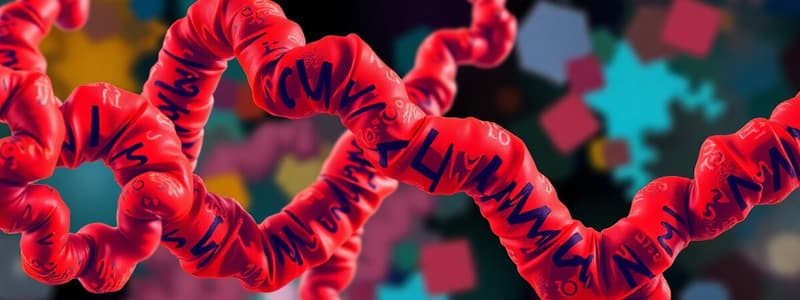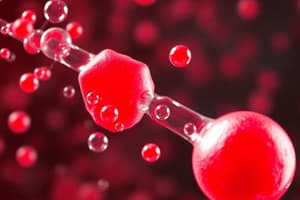Podcast
Questions and Answers
Which of the following stabilizing forces contributes to the tertiary structure of proteins?
Which of the following stabilizing forces contributes to the tertiary structure of proteins?
- Hydrophilic interactions
- Hydrophobic interactions (correct)
- Peptide bonds
- Disulfide bridges (correct)
What best describes the quaternary structure of a protein?
What best describes the quaternary structure of a protein?
- The arrangement of secondary structures
- The linear sequence of amino acids
- An individual polypeptide chain
- The association of multiple polypeptide chains (correct)
How many polypeptide chains are present in adult hemoglobin?
How many polypeptide chains are present in adult hemoglobin?
- 4 beta chains
- 2 alpha chains only
- 2 alpha and 2 beta chains (correct)
- 2 alpha and 2 gamma chains
Which of the following proteins contains both α-helices and β-pleated sheets in its structure?
Which of the following proteins contains both α-helices and β-pleated sheets in its structure?
Which type of protein is characterized by being rod or wire-like in shape?
Which type of protein is characterized by being rod or wire-like in shape?
Fetal hemoglobin differs from adult hemoglobin in that it has a greater affinity for which element?
Fetal hemoglobin differs from adult hemoglobin in that it has a greater affinity for which element?
Which of the following illustrates a common misconception about protein structure?
Which of the following illustrates a common misconception about protein structure?
Vitamin C's role in collagen relates to which aspect of its structure?
Vitamin C's role in collagen relates to which aspect of its structure?
What type of secondary structure is characterized by a coiled spring formation maintained by hydrogen bonds?
What type of secondary structure is characterized by a coiled spring formation maintained by hydrogen bonds?
In β-pleated sheets, what type of bonds hold the polypeptide chains together?
In β-pleated sheets, what type of bonds hold the polypeptide chains together?
What defines the arrangement of R-groups in a β-pleated sheet structure?
What defines the arrangement of R-groups in a β-pleated sheet structure?
What phenomenon allows the formation of secondary structures like α-helices and β-pleated sheets in proteins?
What phenomenon allows the formation of secondary structures like α-helices and β-pleated sheets in proteins?
Which structural feature is NOT typically associated with proteins containing random coil regions?
Which structural feature is NOT typically associated with proteins containing random coil regions?
Which of the following statements about β-pleated sheets is accurate?
Which of the following statements about β-pleated sheets is accurate?
When comparing α-helices and β-pleated sheets, what is a key difference regarding their hydrogen bonding?
When comparing α-helices and β-pleated sheets, what is a key difference regarding their hydrogen bonding?
Which characteristic is NOT typical of the α-helix structure?
Which characteristic is NOT typical of the α-helix structure?
What property is unique to all protein-derived α-amino acids, except for glycine?
What property is unique to all protein-derived α-amino acids, except for glycine?
Which of the following amino acids would most likely carry a positive charge at physiological pH?
Which of the following amino acids would most likely carry a positive charge at physiological pH?
In peptide bond formation, which functional groups are involved?
In peptide bond formation, which functional groups are involved?
Which of the following substances is primarily responsible for transporting oxygen in the blood?
Which of the following substances is primarily responsible for transporting oxygen in the blood?
What is the main difference between polar and nonpolar amino acids at pH 7.0?
What is the main difference between polar and nonpolar amino acids at pH 7.0?
Which amino acid is characterized as the simplest and does not have a chiral center?
Which amino acid is characterized as the simplest and does not have a chiral center?
Which function do antibodies serve in relation to proteins?
Which function do antibodies serve in relation to proteins?
Which of the following represents a feature of casein in milk?
Which of the following represents a feature of casein in milk?
Flashcards
Secondary Structure of Proteins
Secondary Structure of Proteins
The local folding pattern of a polypeptide chain, primarily stabilized by hydrogen bonds. Common examples include alpha-helices and beta-pleated sheets.
Tertiary Structure of Proteins
Tertiary Structure of Proteins
The overall three-dimensional shape of a single polypeptide chain, determined by interactions between amino acid side chains.
Forces Stabilizing Tertiary Structure
Forces Stabilizing Tertiary Structure
Covalent bonds, hydrogen bonds, salt bridges (electrostatic interactions), hydrophobic interactions, and metal ion coordination contribute to the stability of a protein's 3D shape.
Quaternary Structure of Proteins
Quaternary Structure of Proteins
Signup and view all the flashcards
Fibrous Proteins
Fibrous Proteins
Signup and view all the flashcards
Globular Proteins
Globular Proteins
Signup and view all the flashcards
Hemoglobin
Hemoglobin
Signup and view all the flashcards
Myoglobin
Myoglobin
Signup and view all the flashcards
Vitamin C
Vitamin C
Signup and view all the flashcards
Secondary Structure of Proteins
Secondary Structure of Proteins
Signup and view all the flashcards
α-Helix
α-Helix
Signup and view all the flashcards
β-Pleated Sheet
β-Pleated Sheet
Signup and view all the flashcards
Hydrogen Bonds in Secondary Structure
Hydrogen Bonds in Secondary Structure
Signup and view all the flashcards
Intramolecular Hydrogen Bonds
Intramolecular Hydrogen Bonds
Signup and view all the flashcards
Intermolecular Hydrogen Bonds
Intermolecular Hydrogen Bonds
Signup and view all the flashcards
Random Coil
Random Coil
Signup and view all the flashcards
Protein Secondary Structure
Protein Secondary Structure
Signup and view all the flashcards
Polypeptide Chain
Polypeptide Chain
Signup and view all the flashcards
Protein Function: Structure
Protein Function: Structure
Signup and view all the flashcards
Protein Function: Catalysts
Protein Function: Catalysts
Signup and view all the flashcards
Protein Function: Movement
Protein Function: Movement
Signup and view all the flashcards
Protein Function: Transport
Protein Function: Transport
Signup and view all the flashcards
Protein Function: Hormones
Protein Function: Hormones
Signup and view all the flashcards
Protein Function: Protection
Protein Function: Protection
Signup and view all the flashcards
Protein Function: Storage
Protein Function: Storage
Signup and view all the flashcards
Protein Function: Regulation
Protein Function: Regulation
Signup and view all the flashcards
Amino Acid Definition
Amino Acid Definition
Signup and view all the flashcards
Amino Acid: Zwitterion Form
Amino Acid: Zwitterion Form
Signup and view all the flashcards
Amino Acid Chirality
Amino Acid Chirality
Signup and view all the flashcards
Amino Acid Configuration
Amino Acid Configuration
Signup and view all the flashcards
Study Notes
Chapter 21: Amino Acids, Proteins, and Enzymes
- Proteins have various functions, including structure, catalysis, movement, transport, hormones, protection, storage, and regulation.
- Structure: Collagen and keratin are key components of skin, bone, hair, and nails. Keratin also forms the cortex of hair.
- Catalysts: Proteins called enzymes catalyze virtually all reactions in living systems.
- Movement: Muscles are made of myosin and actin proteins.
- Transport: Hemoglobin transports oxygen from lungs to cells, and other proteins transport molecules across cell membranes.
- Hormones: Many hormones are proteins, like insulin, oxytocin, and human growth hormone.
- Protection: Blood clotting involves the protein fibrinogen, and antibodies fight disease.
- Storage: Casein stores nutrients in milk, ovalbumin in eggs, and ferritin in the liver stores iron.
- Regulation: Certain proteins control gene expression, and when gene expression takes place.
Amino Acids
- An amino acid is a compound with both an amino group and a carboxyl group.
- The amino group is attached to the α-carbon adjacent to the carboxyl group.
- The R group, or side chain, determines the identity of the amino acid.
- A-amino acids are typically written in the zwitterion (internal salt) form at physiological pH.
- Glycine is the simplest amino acid (R = H).
- There are 20 common naturally occurring amino acids.
- Essential amino acids are marked with an asterisk (*).
Chirality of α-Amino Acids
- Except for glycine, all protein-derived amino acids are chiral, having at least one stereocenter (the α-carbon).
- Most α-amino acids have an L-configuration at the α-carbon.
Peptides
- Peptides are short polymers of amino acids joined by peptide bonds.
- A peptide bond is the amide bond between the α-carboxyl group of one amino acid and the α-amino group of another.
- Polypeptides are long chains of amino acids joined by peptide bonds.
- Proteins are biological macromolecules consisting of 30-50 or more amino acids joined by peptide bonds.
- Individual amino acid units in a protein are called residues.
- The amino acid with a free -NH3+ group is called the N-terminal amino acid and written on the left.
- The amino acid with a free -COO- group is called the C-terminal amino acid and written on the right.
- The amino acids Ala and Ser can combine by reacting functional groups.
Enzyme Catalysis
- Enzymes are biological catalysts that increase the rate of reactions.
- Enzymes have high specificity and efficiency in catalyzing reactions.
Enzyme Terminology
- Substrate: The compound or compounds whose reaction an enzyme catalyzes.
- Active site: The specific portion of the enzyme to which a substrate binds during a reaction.
Enzyme Specificity
- Lock-and-key model: The active site is a rigid cavity; a substrate must exactly match the shape of the active site to react.
- Induced-fit model: The active site has a flexible shape that adjusts to fit a variety of substrate shapes. The open cavity of the active site adjusts around the substrate for a tighter fit.
Enzyme Activity
- Enzyme activity is a measure of how much a reaction rate is increased over a non-catalyzed reaction.
- Enzyme activity is affected by temperature and pH.
Allosteric Control, Activators, and Inhibitors of Enzyme Activity
- Allosteric control is the binding of a regulator to a site on an enzyme other than the active site, affecting the enzyme's ability to bind a substrate at its active site.
- Activators are substances that initiate or increase enzyme activity.
- Inhibitors are substances that make an enzyme less active or inactive.
- Reversible inhibitors: bind to an enzyme but the enzyme activity is restored when the inhibitor is released.
- Irreversible inhibitors: covalently bind to an enzyme, permanently destroying its activity.
Enzymes in Different Classes
- Enzymes are classified into six major classes according to the types of reactions they catalyze.
- Common examples of enzymes in different classes are mentioned.
Protein Hydrolysis
- Hydrolysis is the breaking of peptide bonds via treatment with aqueous acid, base, or certain enzymes.
- Examples discussed include enzymes involved in protein digestion.
Denaturation of Proteins
- Denaturation is the process of destroying the native conformation of a protein.
- Denaturing agents include heat, urea, surface-active agents, and alcohols.
- Denaturation does not typically break amide bonds responsible for primary structure (peptide bonds).
Cofactors
- Cofactors are metal ions or organic molecules needed for enzyme-catalyzed reactions.
- A common cofactor is, for example, NAD+.
Levels of Protein Structure
- Primary structure: The sequence of amino acids in a polypeptide chain.
- Secondary structure: The 3D arrangement of localized regions within a protein. Common types include α-helices and β-pleated sheets.
- Tertiary structure: The overall 3D conformation of a protein.
- Quaternary structure: Some proteins have more than one polypeptide chain; this structure describes the arrangement of multiple folded polypeptide chains.
Examples of Proteins
- Hemoglobin and myoglobin are common globular proteins.
- Collagen and a-keratins are fibrous proteins.
Studying That Suits You
Use AI to generate personalized quizzes and flashcards to suit your learning preferences.



